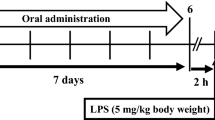Abstract
Lanthanide ions have been proven to have various biologic effects. Lanthanum with extremely active physical and chemical property was evidenced to possess antibacterial and immune adjustment effects. In the present study, the anti-inflammatory effects of lanthanum chloride (LaCl3) on lipopolysaccharide (LPS)-challenged mice were examined in vivo and in vitro. The results indicated that LaCl3 can greatly decrease the secretion of tumor necrosis factor alpha (TNF-α) and interleukin (IL)-1β as well as TNF-α mRNA expression in the mice challenged with LPS. To clarify the mechanism involved, the effects of LaCl3 on the activation of nuclear factor (NF)-κB were examined both in liver and in peritoneal macrophages. The LPS-induced activation of NF-κB was significantly blocked by LaCl3. These findings demonstrate that the inhibition of the LPS-induced inflammatory media, such as TNF-α and IL-1β, by LaCl3, is due to the inhibition of NF-κ B activation.






Similar content being viewed by others
References
Pinsky MR (2007) Sepsis and multiple organ failure. Contrib Nephrol 156:47–63
Shigematsu T (2008) Lanthanum carbonate effectively controls serum phosphate without affecting serum calcium levels in patients undergoing hemodialysis. Ther Apher Dial 12:55–61
Hutchison AJ, Barnett ME, Krause R et al (2009) Lanthanum carbonate treatment, for up to 6 years, is not associated with adverse effects on the liver in patients with chronic kidney disease stage 5 receiving hemodialysis. Clin Nephrol 71:286–295
Hadjiiski OG, Lesseva MI (1999) Comparison of four drugs for local treatment of burn wounds. Eur J Emerg Med 6:41–47
de Gracia CG (2001) An open study comparing topical silver sulfadiazine and topical silver sulfadiazine-cerium nitrate in the treatment of moderate and severe burns. Burns 27:67–74
Roland CR, Naziruddin B, Mohanakumar T et al (1996) Gadolinium chloride inhibits Kupffer cell nitric oxide synthase (iNOS) induction. J Leukoc Biol 60:487–492
Fujii Y, Goldberg P, Hussain SN (1998) Contribution of macrophages to pulmonary nitric oxide production in septic shock. Am J Respir Crit Care Med 157:1645–1651
Reed LJ, Munch H (1938) A simple method of estimating fifty percent endpoints. Am J Hyg 27:493–497
Yao YM, Xu CL, Yao FH et al (2006) The pattern of nuclear factor-kappaB activation in rats with endotoxin shock and its role in biopterin-mediated nitric oxide induction. Zhonghua Shao Shang Za Zhi 22:405–410
Denlinger LC, Garis KA, Sommer JA et al (1998) Nuclear translocation of NF-kappaB in lipopolysaccharide-treated macrophages fails to correspond to endotoxicity: evidence suggesting a requirement for a gamma interferon-like signal. Infect Immun 66:1638–1647
Zhang P, Martin M, Michalek S et al (2005) Role of mitogen-activated protein kinases and NF-κB in the regulation of proinflammatory and anti-inflammatory cytokines by porphyromonas gingivalis hemagglutinin B. Infect Immun 73:3990–3998
Cogswell JP, Godlevski MM, Wisely GB et al (1994) NF-kappa B regulates IL-1 beta transcription through a consensus NF-kappa B binding site and a nonconsensus CRE-like site. J Immunol 153:712–723
Parmentier M, Hirani N, Rahman I et al (2000) Regulation of lipopolysaccharide-mediated interleukin-1beta release by N-acetylcysteine in THP-1 cells. Eur Respir J 16:933–939
Li Q, Verma IM (2002) NF-kappaB regulation in the immune system. Nat Rev Immunol 2:725–734
Acknowledgement
The work was supported by the National Natural Science Foundation of China (30660182, 30960405), Natural Science Foundation of Jiangxi Province (2007GZY1132), Scientific Plan of Jiangxi Provincial Department of Public Health (20071041), and Program for Innovative Research Team of Nanchang University.
Author information
Authors and Affiliations
Corresponding author
Rights and permissions
About this article
Cite this article
Guo, F., Guo, X., Xie, A. et al. The Suppressive Effects of Lanthanum on the Production of Inflammatory Mediators in Mice Challenged by LPS. Biol Trace Elem Res 142, 693–703 (2011). https://doi.org/10.1007/s12011-010-8792-0
Received:
Accepted:
Published:
Issue Date:
DOI: https://doi.org/10.1007/s12011-010-8792-0




